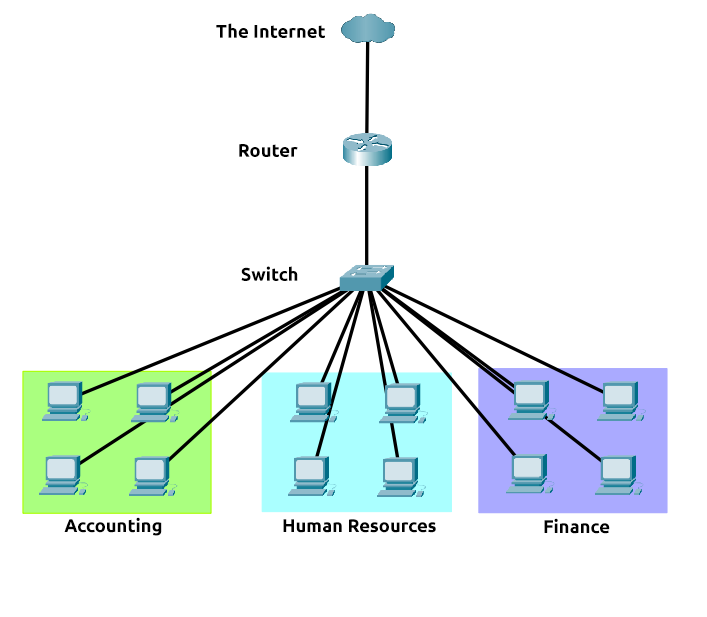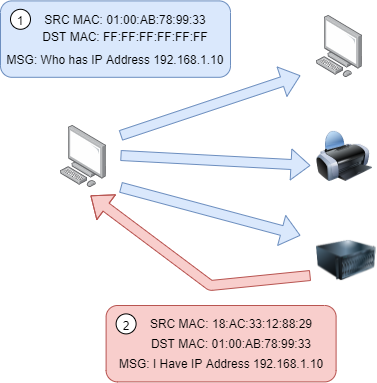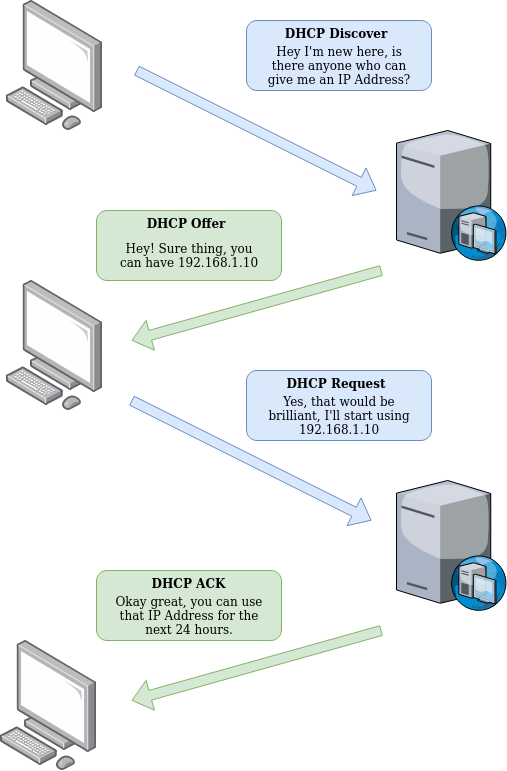LAN
Meaning:
Means Local Area Network (LAN). Over the years, there has been experimentation and implementation of various network designs. One of that aspect is the topology, which refers to the design or look of the network. These include but are not limited to:
Star Topology:
The main premise is that devices are individually connected via a central networking device such as a switch or hub. It is the most commonly found today because of its reliability and scalability, despite its higher cost.
Therefore, any information sent to a device in this topology is sent via the central device to which it connects.

| ADVANTAGES | DISADVANTAGE |
|---|---|
| Higher scalability (easy to add new devices if the need arises). Reduced rate of failure | More expensive. Scaling the network, also increases the maintenance required to keep it functional –> makes troubleshooting faults much harder. Can still fail if the centralized hardware that connects devices fails |
Bus Topology:
It relies upon a single connection, which is known as a backbone cable. This type of topology is similar to the leaf of a tree in the sense that devices (leaves) stem from where the branches are on this cable.

| ADVANTAGES | DISADVANTAGE |
|---|---|
| Easy and cost-efficient to set up, because of not needed cabling or dedicated networking equipment for connecting the devices | Very quickly prone to become slow and bottle necked if devices withing the topology are simultaneously requesting data. Difficulty to troubleshoot, because it becomes hard to identify which device is experiencing issues with data all traveling along the same route. Little redundancy in case of failure, because of a single point of failure along the backbone cable (if it breaks, all devices can no longer receive or transmit data along the bus) |
Ring Topology:
Also known as token topology, boasts some similarities to the bus topology. Devices such as computers are directly connected to each other to form a loop meaning that there is little cabling required and less dependence on dedicated hardware.

It works by sending data across the loop until it reaches the destined device, using other devices along the loop to forward the data. Interestingly, a device will only send data from another device in this topology if it does not have any to send itself. If the device happens to have data to send, it will send its own data first before sending data from another device.
| ADVANTAGES | DISADVANTAGE |
|---|---|
| Easy and cost-efficient to set up, because of not needed cabling or dedicated networking equipment for connecting the devices. Because there is only one direction for data to travel across, it is fairly easy to troubleshoot any faults. Less prone to bottlenecks than bus topology, as large amounts of traffic are not travelling across the network at anyone time | Inefficient because it may have to visit many multiple devices first before reaching the intended device. Fault such as a cut cable or broken device will result in the entire networking breaking |
Switch:
Are dedicated devices within a network that are designed to aggregate multiple other devices such as computers, printers, or any other networking-capable device using ethernet, where they plug into a switchs port.
Switches are usually found in larger networks such as businesses, school, or similair sized networks, where there are mayn devices to connect to the network.
Additionally, switches are much more efficient than their lesser counterpart (hubs / repeaters). They keep track of what device is connected to which part. This way, when they receive a packet, instead of repeating that packet to every port like a hub would do, it just sends it to the intended target, thus reducing network traffic.

Router:
It’s job it to connect networks and pass data between them, it does so by routing.
Routing is the label given to the process of data travelling across networks. It involves creating a path between networks so that this data can be successfully delivered.
Routing is useful when devices are connected by many paths.

Subnetting:
Is the term given to splitting up a network into smaller, miniature networks within itself.
For example a business with different departments such as:
- Accounting
- Finance
- Human Resources

A network needs to know which department to send the information too. Therefore, network administrators use subnetting to categorize and assign specific parts of a network.
That is done by splitting up the number of hosts that can fit within the network, represented by a number called a subnet mask.
A subnet like a IP address is made up of four sections called octets as a number of four bytes (32 bits), ranging from 0 to 255.
Subnets use IP address in three different ways:
- Identify the network address
- Identify the host address
- Identify the default gateway
| TYPE | PURPOSE | EXPLANATION | EXAMPLE |
| Network Address | This address identifies the start of the actual network and is used to identify a networks existence | For example, a device with the IP address of 192.168.1.100 will be on the network identified by 192.168.1.0 | 192.168.1.0 |
| Host Address | An IP address here is used to identify a device on the subnet | For example, a device will have the network address of 192.168.1.1 | 192.168.1.100 |
| Default Gateway | The default gateway address is a special address assigned to a device on the network that is capable of sending information to another network | Any data that needs to go to a device that isn’t on the same network (i.e. isn’t on 192.168.1.0) will be sent to this device. These devices can use any host address but usually use either the first or last host address in a network (.1 or .254) | 192.168.1.254 |
In small networks, creating subnets is not needed as there is an unlikely chance that you need more than 254 devices connected at one time.
However, in bigger networks subnetting can provide a range of benefits including:
- Efficiency
- Security
- Full control
ARP Protocol:
Adress Resolution Protocol is responsible for allowing devices to identify themselves on a network. It does that with allowing devices to associate their MAC address with a IP address on the network. Each device will additionally keep a log of the MAC addresses associated with other devices.
When devices then wish to communicate with another, they will send a broadcast to the entire network searching for a specific device. These devices can then use the ARP protocol to find the MAC address of a device for communication.
How does ARP Work?
Each device in a network has a ledger to store information on (cache). With the ARP protocol, this cache stores the identifiers of other devices on the network.
To map these two identifiers the ARP protocol sends two types of messages:
ARPRequestARPReply
When a ARP request is sent, a message is broadcasted to every other device found on a network by the device, asking whether or not the devices MAC address matches the requested IP address.
If the device does have the requested IP address, an ARP reply is returned to the initial device, which then remembers this information within the cache (ARP entry).

DHCP Protocol:
IP addresses can be assigned either manually, by entering them physically into a device, or automatically and most commonly by using a DHCP (Dynamic Host Configuration Protocol) server.
This works when a device connects to a network and if the IP address has not been manually assigned already, sends out a request (DHCP Discover) to see if any DHCP servers are on the network.
If there are, the DHCP server replies with a IP address the device could use (DHCP Offer). The device then sends a reply confirming it wants the offered IP address (DHCP Request).
Lastly the DHCP server send a reply acknowledging this has been completed, and the device can start using the IP address (DHCP ACK).
